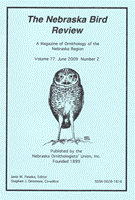Nebraska Ornithologists' Union

Nebraska Bird Review
Date of this Version
12-2008
Document Type
Article
Citation
“Fall Field Days at Ashland” from Nebraska Bird Review (December 2008) 76(4).
Abstract
The Fall Field Days were held southeast of Ashland at the Carol Joy Holling Conference Center September 26-28. Field trips to Platte River and Schramm State Parks, Louisville and Memphis SRAs, Jack Sinn WMA, Fontenelle Forest, and Spring Creek Prairie were led by Kevin Poague, Clem Klaphake, Larry Einemann, Rick Schmid, and Don and Janis Paseka.
Hawk migration was in full swing, and we observed 10 species, including a number of Broad-wings and Swainson's. An American Golden-Plover was a standout among the dozen shorebird species, and 10 warbler species were found, including Black-throated Green and Canada. Total species count was 126.
Our speaker on Friday night was NOU member Dr. Daniel Leger, Professor of Psychology at the University of Nebraska–Lincoln. His presentation was titled “How Many Bird Species Are There and How Do We Know?” His answer was that there are around 10,000 species right now, that number is increasing, and we probably will never know how many species there are. He spoke about "cryptic" species, ones that were there all along but were never noticed because we lacked crucial behavioral, vocal, or genetic data. Dr. Leger's work has included uncovering some cryptic species and will eventually result in the Bright-rumped Attila and the Ochre-bellied Flycatcher each being split into multiple species.
On Saturday night, Dr. Robert Gibson, Professor of Biology at the University of Nebraska–Lincoln, spoke about avian lek behavior. Several hundred species of birds exhibit lek behavior, in which clustered males engage in sometimes spectacular courtship behavior while the females are allowed a relatively unhindered choice of a mate. Dr. Gibson's studies have shown that females favor males in groups and prefer certain lek hotspots that are close to nesting sites. Only a few of the males actually mate, but the others may have more chance of mating if they display at a known lek site. Another advantage is that an individual bird stands a greater chance of survival during a predator attack in a group than it does if it is alone.


Comments
Copyright 2008 Nebraska Ornithologists’ Union. Used by permission.